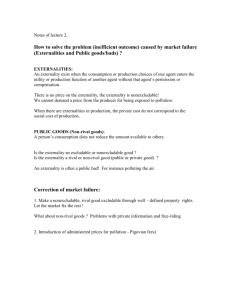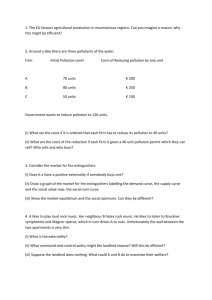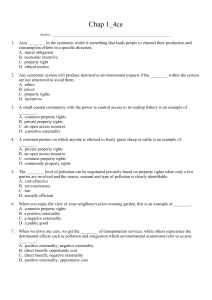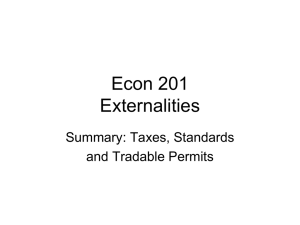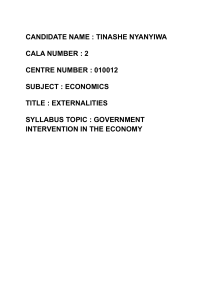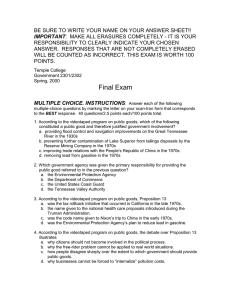Suggested Paper Topics
advertisement
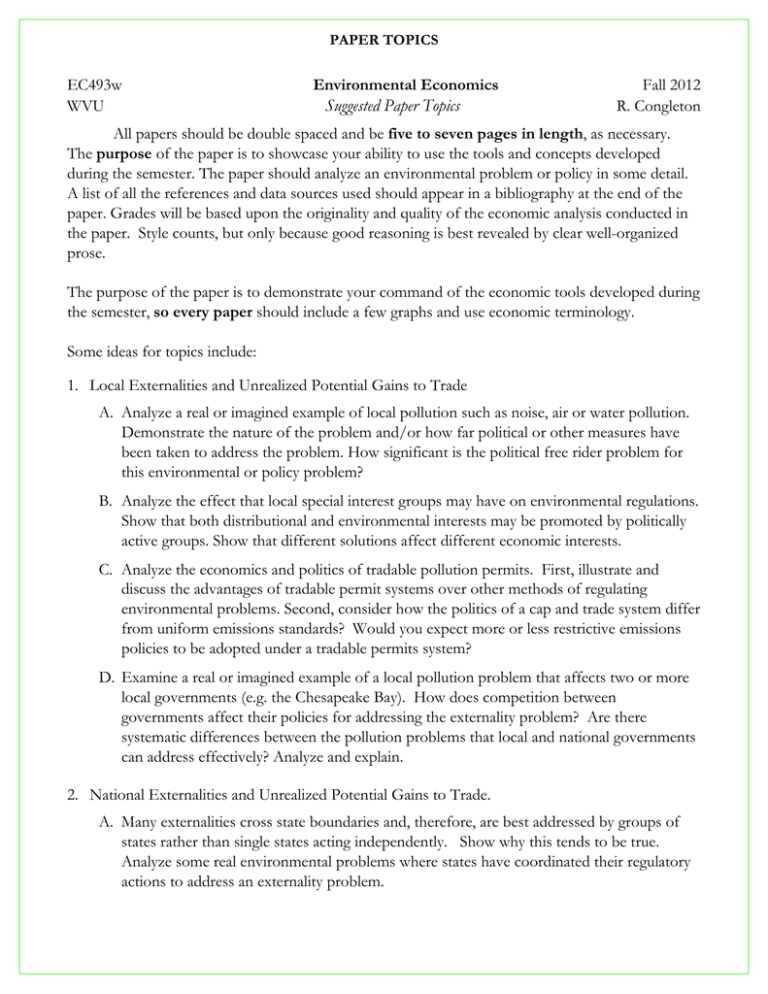
PAPER TOPICS EC493w WVU Environmental Economics Suggested Paper Topics Fall 2012 R. Congleton All papers should be double spaced and be five to seven pages in length, as necessary. The purpose of the paper is to showcase your ability to use the tools and concepts developed during the semester. The paper should analyze an environmental problem or policy in some detail. A list of all the references and data sources used should appear in a bibliography at the end of the paper. Grades will be based upon the originality and quality of the economic analysis conducted in the paper. Style counts, but only because good reasoning is best revealed by clear well-organized prose. The purpose of the paper is to demonstrate your command of the economic tools developed during the semester, so every paper should include a few graphs and use economic terminology. Some ideas for topics include: 1. Local Externalities and Unrealized Potential Gains to Trade A. Analyze a real or imagined example of local pollution such as noise, air or water pollution. Demonstrate the nature of the problem and/or how far political or other measures have been taken to address the problem. How significant is the political free rider problem for this environmental or policy problem? B. Analyze the effect that local special interest groups may have on environmental regulations. Show that both distributional and environmental interests may be promoted by politically active groups. Show that different solutions affect different economic interests. C. Analyze the economics and politics of tradable pollution permits. First, illustrate and discuss the advantages of tradable permit systems over other methods of regulating environmental problems. Second, consider how the politics of a cap and trade system differ from uniform emissions standards? Would you expect more or less restrictive emissions policies to be adopted under a tradable permits system? D. Examine a real or imagined example of a local pollution problem that affects two or more local governments (e.g. the Chesapeake Bay). How does competition between governments affect their policies for addressing the externality problem? Are there systematic differences between the pollution problems that local and national governments can address effectively? Analyze and explain. 2. National Externalities and Unrealized Potential Gains to Trade. A. Many externalities cross state boundaries and, therefore, are best addressed by groups of states rather than single states acting independently. Show why this tends to be true. Analyze some real environmental problems where states have coordinated their regulatory actions to address an externality problem. PAPER TOPICS B. Explain why assigning responsibility to a permanent bureaucracy for environmental regulation tends to encourage increasingly stringent environmental regulation and enforcement because of bureaucratic discretion. C. Analyze one of the alternative energy sources being talked about as a substitute for coal or gasoline as an environmental issue (wind mills, solar, bio mass, ethanol, nuclear, etc.). Will the proposed alternative actually reduce emissions relative to fossil fuels over the life cycle of the alternative method of producing electricity or travel? What are the costs and benefits associated with subsidizing such energy sources? 3. International Externalities and Unrealized Potential Gains to Trade A. Analyze the problems faced by two countries that wish to solve a cross border environmental problem. Explain the reasons why independent adjustment might fail to solve the problem analyzed. Can Coasian contracts be consummated between two countries? (Good examples include (i) pollution levels in a boundary river or lake, and (ii) air pollution that shifts back and forth across a national boundary as winds change directions.) What political model have your assumed in your analysis of treaty negotiations? B. Analyze any multilateral international environmental problem using the tools developed in class. Examples of international externality and commons problems include: global warming, rain forests management, whaling and fishing rights, sulfur emissions, CFC emissions, and mining the ocean floor. Explain why national regulations cannot fully address the problem, and/or the extent to which international treaties have successfully addressed the problem. C. One of the difficulties with analyzing worldwide environmental problems is the determination of both the magnitude and distribution of benefits and costs associated with the problems themselves and alternative solutions. Analyze how imperfect information affects individual perceptions of ideal environmental policies for (1) typical individuals, (2) environmentalists, (4) the bureaucracy and/or (5) profit maximizing interest groups. D. Enforcement of international agreements is a difficult problem because no coercive method can be used. (There is no "world government" or international body with the ability to impose penalties on those who violate treaty obligations or to tax polluters.) Develop a prisoner's dilemma game that illustrates the dilemma faced by countries who sign an agreement that requires two signatory countries to impose more stringent environmental controls on domestic industry. (Each will have incentives to violate the agreement, even though both would benefit if both adhered to the terms of the agreement.) Are there any solutions to this implementation dilemma? Discuss. 4. Many other ideas are also acceptable, but please clear any idea for a project that does not fit neatly into one of these descriptions before you start writing. (I'll let you know whether or not it satisfies the purpose of the course and/or whether it sounds feasible.)




